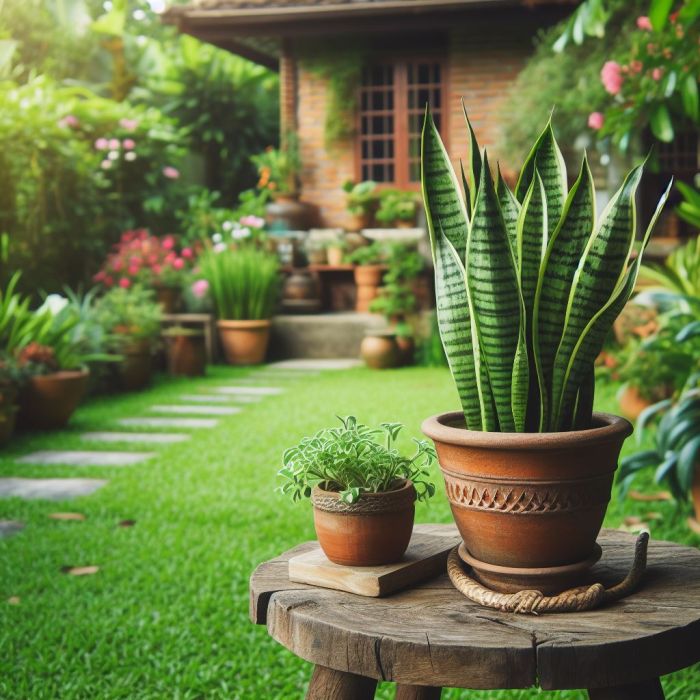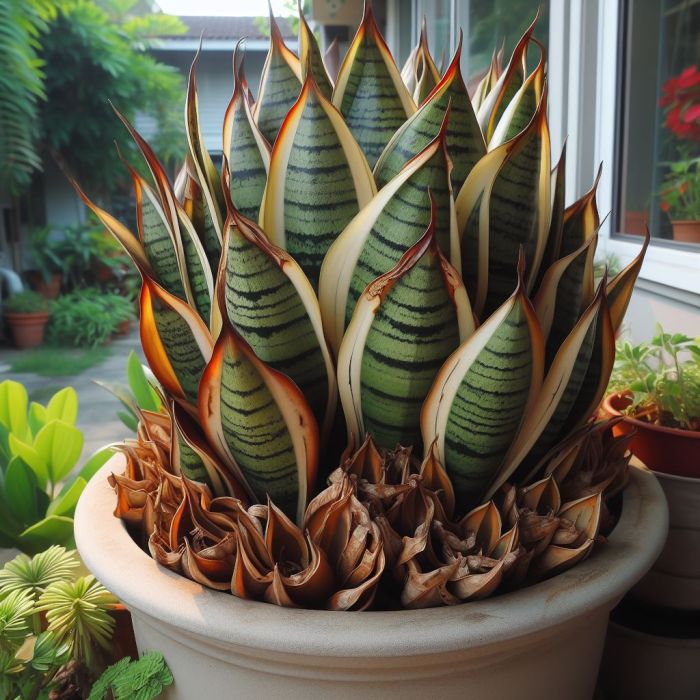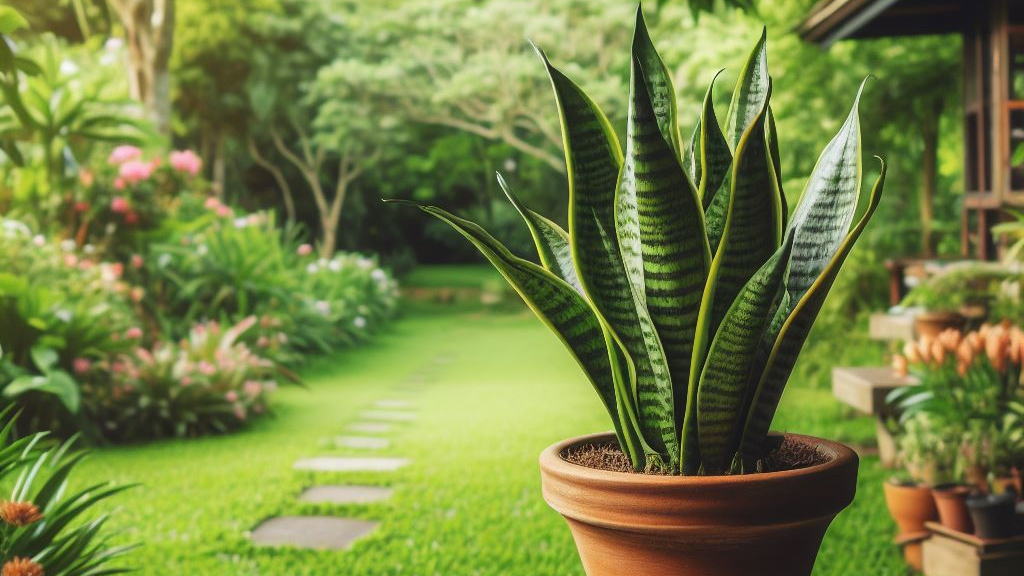Last updated on March 8th, 2024 at 05:55 am
Snake plants, scientifically known as Sansevieria, have long been cherished as beloved indoor houseplants due to their low maintenance and air-purifying qualities. With their striking foliage and resilience to neglect, snake plants have adorned countless homes and offices around the world. However, as plant enthusiasts explore the possibilities of outdoor gardening, a common question arises: Can snake plants live outside? This question prompts a deeper examination of their adaptability to different environments and the factors that contribute to their success.
Contents
- 1 Can Snake Plants Live Outside?
- 2 Can Snake Plants Live Outside: Common Concerns
- 3 FAQs
- 3.1 Can snake plants live outside?
- 3.2 What’s the best time to move snake plants outside?
- 3.3 Can snake plants live outside at any temperature?
- 3.4 How can I prevent sun damage to my snake plant leaves when moving it outside?
- 3.5 What should I do if my snake plant is overexposed to sunlight outdoors?
- 3.6 How often should I water my snake plant when it’s outdoors?
- 3.7 Can snake plants live outside with any potting method?
- 3.8 How can I protect my snake plant from pests outdoors?
- 3.9 Can snake plants live outside during colder weather?
- 3.10 Can snake plants live outside without any specific care tips?
- 3.11 How can I ensure the continued health of my snake plant when transitioning it between indoor and outdoor environments?
- 4 Author
Can Snake Plants Live Outside?

In this comprehensive guide, we’ll explore whether snake plants can thrive outdoors, addressing a common question among gardeners: Can snake plants live outside? From understanding their ideal temperature requirements to mastering the art of outdoor care, we aim to provide invaluable insights for enthusiasts eager to extend their green thumb beyond the confines of indoor spaces. Join us as we uncover the secrets to cultivating thriving snake plants in outdoor settings.
Right Time For Moving Plant Outside
Choosing the right time to move snake plants outside is crucial for their successful transition and long-term health. It’s advisable to opt for late spring or early summer for outdoor relocation, as this timeframe coincides with warmer weather conditions. Snake plants thrive best within a temperature range of approximately 60°F to 85°F (15°C to 29°C). Warmer temperatures provide an optimal environment for acclimating snake plants to their new outdoor surroundings, promoting healthy growth and development.

However, it’s important to note that high temperatures can have adverse effects on snake plants, such as scorching leaves. Excessive heat can cause the leaves to become discolored or develop brown patches, compromising the plant’s overall appearance and health. Therefore, monitoring temperature levels and providing adequate shade during periods of intense heat is essential to prevent damage and ensure the well-being of snake plants outdoors. With proper care and attention, snake plants can thrive outside, enhancing outdoor spaces with their unique beauty and air-purifying properties.
Best Practices for Moving Snake Plants Outside
When moving snake plants from indoor to outdoor environments, it’s crucial to consider their previous exposure to indoor lighting. If the plant has been accustomed to limited indirect sunlight indoors, it’s best to introduce it gradually to brighter outdoor conditions. Start by placing the plant in a partially shaded area and gradually increase its exposure to sunlight over time, allowing it to adjust and thrive in its new outdoor environment.
Additionally, ensuring the plant receives three to four hours of direct sunlight daily outdoors is important for its growth and well-being. Since snake plants prefer dry soil, it’s essential to avoid over-watering. If you live in a rainy area, wait until the rainy season is over, or use pots with drainage holes to prevent waterlogging.
Care Tips for Snake Plants Outside
When caring for snake plants outside, it’s essential to provide them with the appropriate conditions to thrive. Firstly, ensure that the plant is placed in a location that receives indirect sunlight to prevent sunburn and leaf damage. While snake plants can tolerate low light conditions, they may not thrive in deep shade.
Additionally, opt for well-draining soil to avoid waterlogging, which can lead to root rot. Snake plants prefer slightly dry conditions, so it’s crucial to avoid overwatering. If you’re uncertain about watering frequency, err on the side of underwatering rather than overwatering. This approach helps prevent issues related to excessive moisture in the soil, which can be detrimental to the plant’s health.
Remember to monitor the soil moisture levels and only water when the top inch of soil is dry. By following these care tips, you can help ensure the health and vitality of your snake plant outdoors while addressing the question: can snake plants live outside?
Bringing Snake Plants Back Indoors

Bringing snake plants back indoors is a crucial step in ensuring their well-being, particularly as colder temperatures approach in the fall. It’s generally advisable to relocate snake plants indoors before the onset of colder weather to protect them from potential frost damage. As temperatures drop, outdoor conditions may become less favorable for the plant’s growth and health.
When reintroducing snake plants to indoor conditions, it’s essential to do so gradually to minimize shock and stress. Begin by placing the plant in a partially shaded area indoors to gradually reduce its exposure to sunlight. This gradual transition allows the plant to adjust to lower light levels without experiencing undue stress or leaf damage.
Additionally, be mindful of potential pests that may have taken residence on the plant while it was outdoors. Inspect the plant carefully for any signs of pest infestation and take appropriate measures to address them before bringing the plant indoors.
Can Snake Plants Live Outside: Common Concerns
When considering can snake plants live outside? several common concerns arise that require attention to ensure the plants thrive in their new environment.
One prevalent concern is pest management, as outdoor environments may expose snake plants to a variety of pests such as aphids or spider mites. It’s essential to be vigilant and regularly inspect the plant for signs of infestation, such as yellowing leaves or webbing. If pests are detected, consider using natural or chemical remedies to address the issue effectively. For example, introducing beneficial insects like ladybugs can help control aphid populations, while neem oil or insecticidal soap can combat spider mites.
Another important aspect to consider is the potting process, especially when selecting the container and soil type. It’s vital to choose pots equipped with drainage holes to avert waterlogging, a condition that could result in root decay and other moisture-related complications. Furthermore, utilizing soil that promotes good drainage is imperative to create the ideal environment for snake plants outdoors. If the plant exceeds the confines of its current container, it’s advisable to transplant it into a larger pot with new soil to facilitate its continued growth.
In addition to addressing common concerns, providing troubleshooting tips for issues like overexposure to sunlight or inadequate watering is crucial for successful outdoor cultivation. If a snake plant shows signs of sunburn or leaf discoloration due to excessive sunlight, consider moving it to a partially shaded area to alleviate the problem. Similarly, adjusting the watering frequency based on outdoor conditions and monitoring soil moisture levels can help prevent issues related to under or overwatering. Using a moisture meter can provide accurate readings and guide watering practices effectively.
FAQs
Can snake plants live outside?
Yes, snake plants can thrive outdoors when provided with the right conditions and care.
What’s the best time to move snake plants outside?
Late spring or early summer is ideal for outdoor relocation, coinciding with warmer weather conditions that promote healthy growth.
Can snake plants live outside at any temperature?
Snake plants prefer temperatures between 60°F to 85°F (15°C to 29°C) for optimal growth. However, they can tolerate slight fluctuations within this range.
How can I prevent sun damage to my snake plant leaves when moving it outside?
Gradually acclimate the plant to increased sunlight by starting it in a partially shaded area and gradually exposing it to more sunlight over time.
What should I do if my snake plant is overexposed to sunlight outdoors?
If you notice signs of sunburn or leaf discoloration, move the plant to a partially shaded area to alleviate stress and prevent further damage.
How often should I water my snake plant when it’s outdoors?
Monitor soil moisture levels and water the plant when the top inch of soil is dry. Adjust the watering frequency based on outdoor conditions to prevent over or under-watering.
Can snake plants live outside with any potting method?
Choose pots with drainage holes to prevent waterlogging, and use well-draining soil to ensure optimal growing conditions.
How can I protect my snake plant from pests outdoors?
Regularly inspect the plant for signs of pests like aphids or spider mites, and use natural or chemical remedies as necessary to address infestations.
Can snake plants live outside during colder weather?
No, it’s advisable to relocate snake plants indoors before the onset of colder temperatures to protect them from potential frost damage.
Can snake plants live outside without any specific care tips?
While snake plants are hardy and can survive outdoors with minimal care, providing specific care tips ensures their optimal growth and health in outdoor environments.
How can I ensure the continued health of my snake plant when transitioning it between indoor and outdoor environments?
Monitor environmental conditions, provide appropriate care based on the plant’s needs, and address any issues promptly to promote its overall well-being.
In conclusion, snake plants, also known as Sansevieria, can thrive outdoors with the right care. Through this guide, we’ve explored how to ensure their success outside, addressing the question, “Can snake plants live outside?” By providing optimal conditions, such as appropriate temperature, sunlight exposure, and well-draining soil, enthusiasts can enjoy the beauty and benefits of snake plants in outdoor settings. With proper care and attention, snake plants can flourish outdoors, proving that they can indeed live outside.

